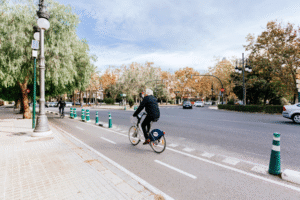
E-bikes have become a popular mode of transportation in New York, offering an economical and environmentally friendly alternative for commuting and recreation. Their convenience and efficiency make them a practical choice where traffic congestion is a daily challenge. However, like any vehicle, e-bikes require careful use to prevent accidents, which can lead to serious injuries and legal issues. Knowing the appropriate steps to take after an accident can protect your rights and influence the outcome of your claim.
A skilled Queens personal injury attorney can provide clear guidance on the legal aspects of your case, helping you understand your rights under New York law and advocating for fair compensation. Having a knowledgeable legal ally can make a significant difference in achieving a just resolution. If you’ve been involved in an e-bike accident, taking proactive steps and seeking experienced legal representation can help you move forward with confidence.
What is Project MOVER?
Project MOVER is an initiative aimed at expanding mobility options within the Village of Ossining and neighboring communities in Westchester County, New York. Launched in Summer 2024, the program offers various services, including an E-Bike Share, E-Bike Library, and an E-Bike Ownership Pathway Program, to provide accessible and sustainable transportation alternatives to residents and visitors.
The program has significantly increased the utility and popularity of e-bikes in the area, offering a practical solution for those who prefer not to drive, find driving economically unfeasible, or seek a quick and enjoyable way to navigate the village.
The success of Project MOVER in Ossining has not only improved local mobility but also served as a model for neighboring communities. Villages such as Tarrytown, Sleepy Hollow, Dobbs Ferry, and Croton-on-Hudson are exploring similar programs, inspired by Ossining’s initiative to enhance transportation options and promote environmental sustainability.
By embracing e-bike programs like Project MOVER, communities can provide residents with efficient, eco-friendly transportation choices, contributing to reduced traffic congestion and a healthier environment.
However, as e-bike usage continues to rise in New York, so does the importance of being prepared for potential accidents. In 2023, e-bikes were involved in 23 of the 30 cyclist fatalities in New York City, marking a 23-year high in bike-related deaths. With increased speed capabilities and widespread adoption, e-bike riders should be well-informed about the necessary steps to take following an accident to protect their rights and well-being.
Immediate Steps to Take After an E-bike Accident in New York
After an e-bike accident, the actions you take can significantly impact both your health and any potential legal claims. Acting quickly and decisively helps protect your well-being and ensures that essential details are documented for future use. Here are the key steps to take immediately after an e-bike accident:
Prioritize Your Safety and Check for Injuries
Your first concern should always be your safety and the safety of others involved.
- Take a moment to assess your physical condition. Look for visible injuries and check for pain or discomfort that could indicate internal damage.
- Move to a safe location if you are in immediate danger, such as in the path of traffic.
- If you’re unable to move or feel severe pain, remain where you are and wait for emergency responders to arrive.
Even if you feel uninjured, the adrenaline from the accident might mask symptoms. Avoid dismissing any physical signs of injury, as they could worsen without proper evaluation.
Call 911 to Report the Accident and Request Assistance
In New York, reporting an e-bike accident to the authorities is an essential step.
- Contact 911 to report the crash, regardless of its severity. Police officers will create an official accident report, which can serve as critical evidence if you decide to file a claim.
- Provide accurate and detailed information to the dispatcher, including your location, the nature of the accident, and details about any injuries.
- Request medical assistance if anyone involved appears injured. Emergency medical personnel can provide immediate care and document injuries on-site.
Failing to report the accident may create challenges later, especially if you need to establish liability or verify the circumstances of the crash.
Gather Evidence at the Scene, Including Photos and Witness Information

Collecting evidence at the scene of the accident can strengthen your legal claim and provide clarity about what happened. You or a trusted individual, if you have been injured, can proceed with the following to collect necessary information to support your claim:
- Take photos of your e-bike, the other vehicle(s) involved, road conditions, traffic signals, and any visible injuries. Images captured immediately after the accident can prevent disputes over the facts later.
- Speak with witnesses who saw the accident and ask for their contact information. Their accounts may provide valuable support to your version of events.
- If possible, note the driver’s license plate number, insurance details, and contact information.
Details collected at the scene are often more accurate than relying on memory days or weeks later.
Seek Medical Attention Even if Injuries Seem Minor
Medical care should always be a priority after an e-bike accident, even if you feel fine.
- Some injuries, such as concussions, soft tissue damage, or internal bleeding, may not show immediate symptoms but can worsen over time. A medical professional can identify and treat these issues early.
- Visiting a doctor creates a medical record of your injuries, which may be necessary for insurance claims or legal proceedings. Keep copies of all medical reports, diagnoses, and bills.
- Follow any treatment plans or recommendations provided by the healthcare provider. Ignoring medical advice can undermine your recovery and affect your ability to recover compensation.
Delaying medical care not only puts your health at risk but may also weaken your case, as insurers may argue that your injuries were not caused by the accident. These immediate steps lay the foundation for protecting your health and your rights. Acting quickly and keeping detailed records can make all the difference as you move forward.
Understanding New York’s E-bike Laws and Your Rights
New York has specific laws governing e-bike usage, which play a key role in determining liability and protecting your rights after an accident. Whether you’re a rider, pedestrian, or motorist, knowing the rules and legal principles can help clarify your position in the aftermath of an e-bike collision.
What Are New York’s Rules for E-bike Riders?
E-bikes in New York are regulated differently than traditional bicycles or motor vehicles. Riders must follow specific rules to operate them legally:
- E-bikes are categorized into three classes based on their speed and operational features. For example, Class 1 and Class 2 e-bikes have a maximum speed of 20 mph, while Class 3 e-bikes can reach up to 25 mph.
- Riders must be at least 16 years old, and helmets are required for Class 3 e-bike riders.
- E-bikes are prohibited from being ridden on sidewalks. They must stay on designated bike paths or roadways unless otherwise permitted.
- Riders must follow all traffic laws, including stopping at red lights, yielding to pedestrians, and using proper hand signals when turning.
Violating these laws could impact your ability to recover compensation in an accident, as it may be considered contributory negligence.
How to Determine Liability in an E-bike Accident
Liability in an e-bike accident depends on who acted negligently or failed to meet their duty of care:
- If a motorist hit you, their liability may stem from reckless driving, failure to yield, distracted driving, or other traffic violations.
- If the accident involved a pedestrian, liability could hinge on whether the pedestrian acted in a way that caused the collision, such as jaywalking.
- In cases involving defective e-bikes, the manufacturer or retailer may be liable if a design or production flaw contributed to the crash.
- ·Riders themselves may share liability if they were operating the e-bike recklessly or in violation of traffic laws.
New York courts examine all available evidence, such as police reports, witness statements, and physical evidence, to assign fault.
How Comparative Negligence Affects Your Case in New York
New York follows a pure comparative negligence rule, which means that even if you are partially at fault for the accident, you can still recover compensation. However, the amount you receive will be reduced by your percentage of fault.
For example:
- If you were 20% at fault for the accident because you failed to signal a turn, and your total damages are $20,000, you would receive $16,000 (80% of the total).
- If you were 80% at fault, you could still recover 20% of your damages, but the compensation would be significantly reduced.
This rule emphasizes the importance of gathering evidence and presenting a strong case to minimize any assigned fault that could reduce your compensation.
E-bike riders in New York have specific rights and responsibilities. Knowing these laws can help clarify your legal position and protect your claim. Each aspect of liability and negligence is carefully evaluated, making it critical to act thoughtfully after an accident.
Common Causes of E-bike Accidents in New York
E-bike accidents can occur for various reasons, many of which stem from preventable factors. Identifying the common causes of these accidents is critical for understanding liability and taking steps to prevent future incidents. Below are some of the primary causes of e-bike accidents in New York, with considerations for local traffic laws and infrastructure.
Driver Negligence and Unsafe Road Behavior
Motorist’s actions are one of the leading causes of e-bike accidents in New York. Drivers have a legal duty to exercise care when sharing the road with e-bike riders, but negligent behavior often leads to collisions.
Some common examples of driver negligence include:
- Distracted Driving: Drivers using mobile phones, adjusting GPS devices, or engaging in other distractions may fail to notice e-bike riders on the road.
- Failure to Yield: E-bike riders have the same rights as other vehicles in many situations. Drivers who fail to yield at intersections or when making turns can cause serious accidents.
- Aggressive Driving: Speeding, tailgating, and reckless lane changes increase the risk of collisions with e-bike riders, who are more vulnerable due to the lack of physical protection.
- Blind Spots: Drivers may fail to check blind spots when merging or turning, especially in busy urban areas like Queens, where traffic is dense.
When a driver’s negligence causes an accident, they may be held liable for the resulting injuries and damages.
Hazardous Road Conditions and Infrastructure Issues
The condition of New York’s roads and bike lanes plays a significant role in e-bike safety. Poorly maintained infrastructure can create dangerous situations for riders.
Some common hazards include:
- Potholes and Road Debris: Uneven surfaces, broken pavement, and debris can cause e-bike riders to lose control or crash.
- Lack of Bike Lanes: Although New York City and surrounding communities have worked to expand their bike lane networks, some areas lack safe, designated spaces for e-bike riders. Sharing the road with cars can lead to accidents, especially on narrow streets.
- Poor Lighting: Insufficient street lighting, particularly in residential or suburban areas, makes it harder for drivers to see e-bike riders at night.
- Obstructed Signage: Missing or obstructed traffic signs can lead to confusion about right-of-way or expected behavior at intersections.
- In cases where government entities or private property owners fail to maintain safe roadways, they may bear partial liability for accidents caused by hazardous conditions.
Manufacturing Defects or Malfunctions in E-bikes
E-bike accidents can also result from issues with the bike itself. Defective parts, improper assembly, or software malfunctions may cause the rider to lose control or experience sudden failures while operating the bike.
Examples of common e-bike defects include:
- Battery Failures: Overheating or defective batteries can lead to fires or sudden power loss while riding.
- Brake Malfunctions: Faulty brakes may fail to stop the bike in time, especially during emergencies.
- Motor Issues: Problems with the motor can cause the bike to accelerate unexpectedly or fail to operate at safe speeds.
- Structural Weaknesses: Frames or wheels that are poorly designed or constructed may break under normal use, leading to crashes.
In such cases, the manufacturer, distributor, or retailer of the e-bike may be held liable through a product liability claim. These claims often involve proving that the defect existed when the product left the manufacturer and directly caused the accident.
E-bike accidents in New York often result from a combination of human error, environmental factors, and mechanical failures. Identifying the cause of the accident is a crucial step in determining liability and pursuing appropriate compensation. A skilled personal injury attorney can
Filing a Personal Injury Claim After an E-bike Accident in New York
If you’ve been involved in an e-bike accident in New York, filing a personal injury claim can help you recover compensation for medical bills, lost wages, and other damages. This process requires a clear understanding of the role of insurance, how fault is determined, and the time limits for taking legal action.
How Insurance Works in E-bike Accident Claims
Insurance coverage plays a central role in compensating victims of e-bike accidents, but the type of coverage available depends on the specifics of the case.
- Motorist’s Insurance: If a motor vehicle was involved in the accident, the driver’s auto insurance policy might cover your injuries and property damage. New York is a no-fault insurance state, meaning the driver’s personal injury protection (PIP) coverage may pay for your medical expenses and lost wages regardless of who caused the accident.
- Homeowner’s or Renter’s Insurance: In cases where a pedestrian or another cyclist caused the accident, their homeowner’s or renter’s insurance might cover your damages if they were negligent.
- E-bike Insurance: If you have e-bike-specific insurance, it may provide coverage for injuries, property damage, or liability.
- Uninsured/Underinsured Motorist Coverage: If the at-fault party lacks adequate insurance, your own uninsured/underinsured motorist coverage (if available) may help cover your losses.
Understanding which insurance policies apply is essential for recovering the full compensation you are entitled to under New York law.
How to Prove Fault and Negligence in Your Case
Establishing fault and proving negligence are critical components of a personal injury claim. New York follows a comparative negligence rule, so identifying each party’s level of responsibility is essential.
To prove negligence, you must demonstrate the following elements:
1. Duty of Care: The at-fault party owed you a legal duty of care. For instance, drivers must obey traffic laws and operate their vehicles safely around cyclists.
2. Breach of Duty: The at-fault party failed to uphold their duty of care. Examples include distracted driving, running a red light, or failing to yield to an e-bike rider.
3. Causation: The breach of duty directly caused the accident and your injuries. This requires showing a clear link between the other party’s actions and the harm you suffered.
4. Damages: You sustained measurable losses, such as medical expenses, lost income, or pain and suffering, as a result of the accident.
Evidence like police reports, medical records, photos, and witness statements can support your claim and help establish the other party’s fault.
What is the Statute of Limitations for Personal Injury in New York?
The statute of limitations sets a deadline for filing a personal injury lawsuit. In New York, you generally have three years from the date of the accident to file a claim.
- Missing this deadline can result in losing your right to pursue compensation, regardless of the strength of your case.
- If the accident involved a government entity (e.g., a city-owned vehicle or poorly maintained public property), you must file a notice of claim within 90 days and may have a shorter timeframe to bring a lawsuit.
- Certain exceptions, such as cases involving minors or individuals with disabilities, may extend the statute of limitations in specific situations.
- Acting within the legal timeframe is crucial to preserving your rights and avoiding unnecessary complications in your case.
Filing a personal injury claim after an e-bike accident requires a thorough approach to insurance, proof of negligence, and timing. Each step of the process influences your ability to recover fair compensation for your injuries and losses under New York law.
Moving Forward After an E-bike Accident
Recovering after an e-bike accident can be a challenging experience, both physically and emotionally. The legal process may feel overwhelming, but you don’t have to face it alone. A skilled Queens personal injury attorney can help you take control of your situation by clarifying your legal rights, addressing your concerns, and advocating for the compensation you deserve.
Whether it’s negotiating with insurance companies, gathering evidence, or building a strong case on your behalf, having the right support can make all the difference in your recovery journey. If you’ve been injured in an e-bike accident in New York, take the first step toward protecting your future. Consult a skilled personal injury attorney today to discuss your case and explore how legal representation can help you secure fair compensation.






